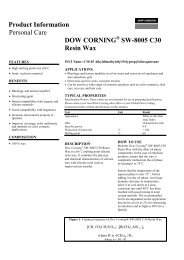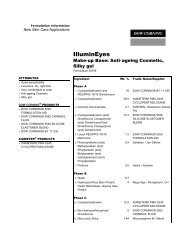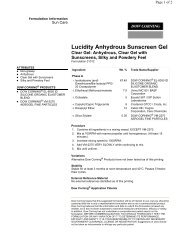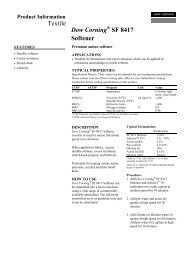Silicone rubber transfer molding
Silicone rubber transfer molding
Silicone rubber transfer molding
You also want an ePaper? Increase the reach of your titles
YUMPU automatically turns print PDFs into web optimized ePapers that Google loves.
MOULDING OF SILASTIC SILICONE RUBBER<br />
Transfer Moulding<br />
In <strong>transfer</strong> moulding, the unvulcanized <strong>rubber</strong> is placed in a<br />
chamber (called a pot), usually at the top of the mould, and<br />
the assembly is placed in a press. The press applies pressure<br />
to a piston-Ike plug in the open end of the pot, clamping the<br />
halves of the mould together and forcing the <strong>rubber</strong> to flow<br />
through one or more sprues into the heated mould.<br />
Transfer moulding is particularly useful in producing parts<br />
whose shape is such that the moulds cannot provide good<br />
flow and tend to trap air. It is the best method of moulding<br />
parts that contain wires, pins and other inserts that require<br />
precise positioning.In some cases, the pot is built into the<br />
mould. In others, the pot is separate from the mould and is<br />
positioned by pins or location marks. In the latter case, the<br />
pot is usually removed immedately after the mould is filled,<br />
to prevent vulcanization of the <strong>rubber</strong> in the pot. With this<br />
system, the pot can be filled with enough <strong>rubber</strong> to load the<br />
mould several times.<br />
Moulding Time and Temperature<br />
The time and temperature for <strong>transfer</strong> moulding are the same<br />
as for compression moulding. The figures given in Table II<br />
are typical; but for each specific moulding job, the most<br />
favourable values of time and temperature can only be<br />
determined by experimentation.<br />
Shrinkage<br />
Most products moulded with Silastic silicone <strong>rubber</strong> shrink<br />
during vulcanization and oven cure. Thus, the finished parts<br />
are smaller than the mould cavities in which they were<br />
formed. The amount of linear shrinkage ranges from about 2<br />
percent to 5 percent depending on the composition of the<br />
moulding <strong>rubber</strong>, the moulding temperature, and the size and<br />
shape of the part. There are two principal causes of<br />
shrinkage:<br />
• The coefficient of thermal expansion of silicone <strong>rubber</strong> is<br />
greater than that of the steel mould. Therefore, when the<br />
moulded part cools to room temperature, it is smaller than<br />
the mould cavity at room temperature.<br />
• During vulcanization and oven curing, decomposition<br />
products of the vulcanizing agent and volatile components<br />
of the <strong>rubber</strong> are driven off, decreasing the size of the<br />
moulding.<br />
• Moulded parts can be held within commercial tolerances,<br />
by using <strong>rubber</strong> of consistent shrinkage and controlling the<br />
processing variables.<br />
3
Fig. 10. Typical <strong>transfer</strong><br />
4










